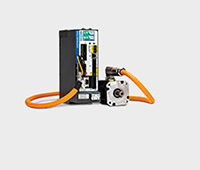Reducing MEMS wear and stiction requires controlling the topography and chemical composition of MEMS contacting surfaces during manufacturing. But reducing wear and stiction isn’t just about the type of coating used; it’s also about the process. As MEMS become smaller, it’s increasingly difficult to apply a complete coating to the entire surface of these mechanical systems.
To combat this challenge, California-based company Applied Microstructures (AMST) developed a new technology platform for MEMS coating applications, called Molecular Vapor Deposition (MVD). MVD technology uses vapor deposition at low temperatures to deposit ultra-thin films on a broad range of substrate materials.
![MVD300E-8B[1]](/wp-content/uploads/2016/07/MVD300E-8B1.jpg) AMST’s MVD300 product handles the MVD process. The MVD300 integrates several different systems that, together, perform the MEMS coating process. The complete system includes a programmable logic controller (PLC) for process control, an industrial PC running an operator interface, (Human Machine Interface) and the equipment front-end module (EFEM).
AMST’s MVD300 product handles the MVD process. The MVD300 integrates several different systems that, together, perform the MEMS coating process. The complete system includes a programmable logic controller (PLC) for process control, an industrial PC running an operator interface, (Human Machine Interface) and the equipment front-end module (EFEM).
Lindsey Eastburn, Senior Software Engineer at AMST, knew that integrating these different systems and getting them to work together as one cohesive system would be a tough task. Eastburn also felt the PLC-based control system and related custom communication protocol would slow down custom application development. AMST’s customers were specifically in need of fast EFEM reconfiguration for running different MEMS coating jobs, increased flexibility in EFEM workflows.
Eastburn decided the EFEM’s control system needed to be replaced with an alternative that could meet the integration challenges he faced in developing the MVD300. He and his colleagues turned to the Opto 22 SNAP PAC control system to interface the separate systems in the MVD300, as well as provide system-wide control and monitoring capabilities.
“We found the SNAP PAC system had a better overall capability to scale from a small application to a large application, and do so without having to change much in software or hardware other than adding additional I/O, says Eastburn.”
“The system is flexible and fits into a range of application scenarios. And the software and hardware tools are organized and structured to support fundamental engineering and problem solving, instead of having to completely tailor your engineering approach around a specific control system.”
I/O configuration tools included with the SNAP PAC control system allowed AMST hardware engineers to get their system up and running without having to use an HMI. These I/O configuration tools also made troubleshooting and diagnostics easy to perform, even before an application was in place. The SNAP PAC also provided a variety of I/O layout and I/O module options to meet AMST’s application needs.
AMST used Opto 22’s high-density I/O modules to save space in the MVD300 tool. The MVD300’s hardware layout consists of a SNAP-PAC-R2 controller, a fully populated 8-module rack with five 32-point digital input modules and three 32-point digital output modules.

“We fully populated the rack [with I/O modules] but didn’t use all of the I/O points on each module,” says Eastburn. “We wanted to have a number of discrete and analog inputs for future sensor connections. So our tool management software reads all inputs and maps them to the Modbus/TCP interface, and the client application uses whatever I/O is needed. If we add devices later we can update the client without changing anything else.”
AMST also took advantage of the dual Ethernet interfaces on the SNAP-PAC-R2 controller. With dual Ethernet interfaces AMST was able to isolate functions of the tool on its own networks to reduce network latency and improve network response time. One network interface is used for a double-armed robot that grabs wafers and loads them into the tool. The other interface is connected to the process control network.
AMST also leveraged the SNAP PAC controller’s enhanced communication support in their application development. The SNAP PAC controller sends a heartbeat signal between itself and the EFEM. If the connection is dropped, the SNAP PAC System controls a tower stack light to let the operator know there is a problem.
The EFEM and SNAP PAC controller also exchange communication over Ethernet using the Modbus/TCP protocol. Polling I/O status from the EFEM is easy to do over Modbus using the SNAP PAC controller’s built-in scratch pad memory space. The SNAP PAC System also reads all EFEM environmental signals using the Modbus/TCP protocol.
With the success AMST has seen with the MVD300, they’re planning to use the SNAP PAC System to automate their next-generation EFEM and enhance system communication even further.
Opto 22
www.opto22.com
Filed Under: I/O modules, MOTION CONTROL, PCs, PLCs + PACs





Tell Us What You Think!